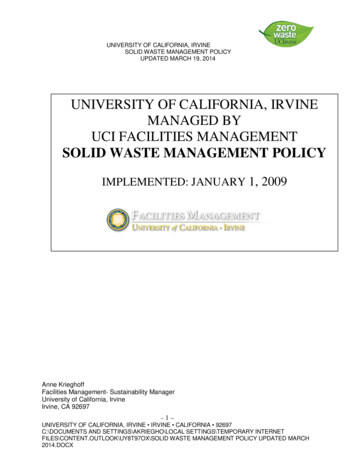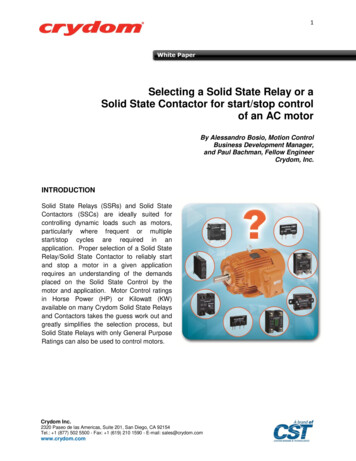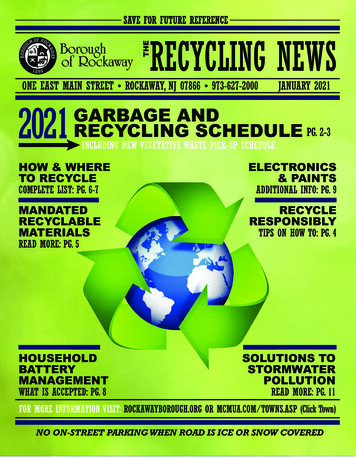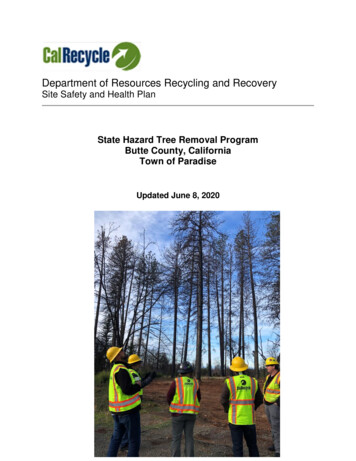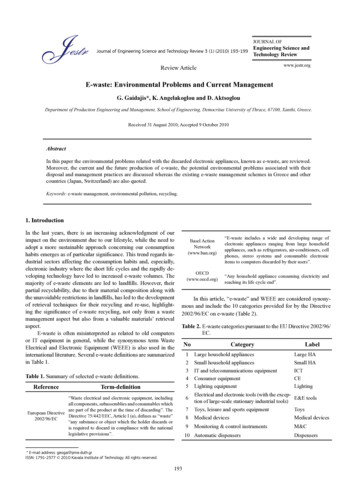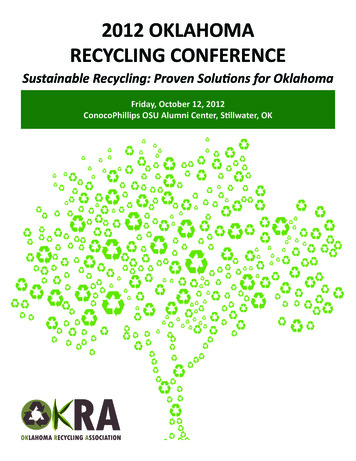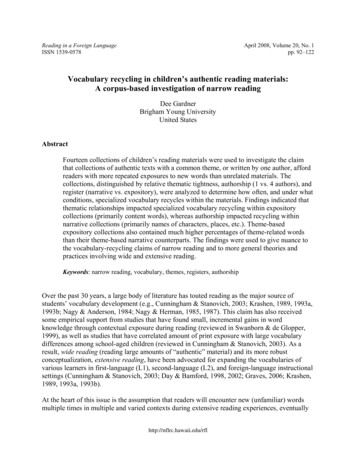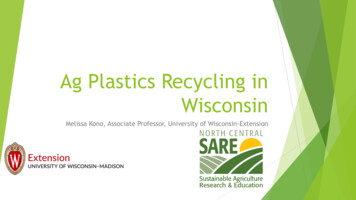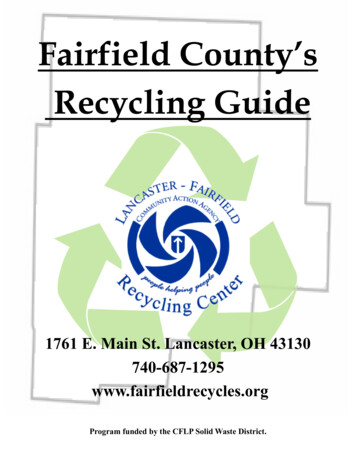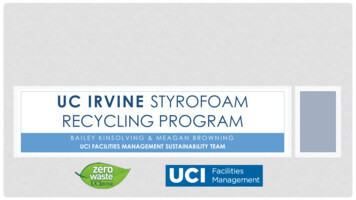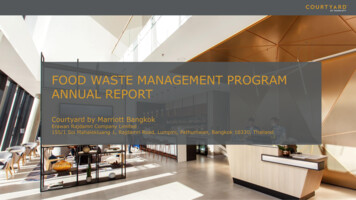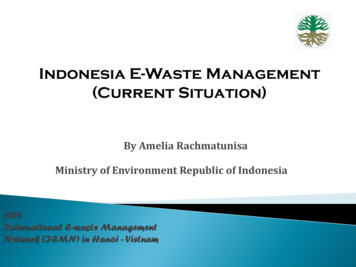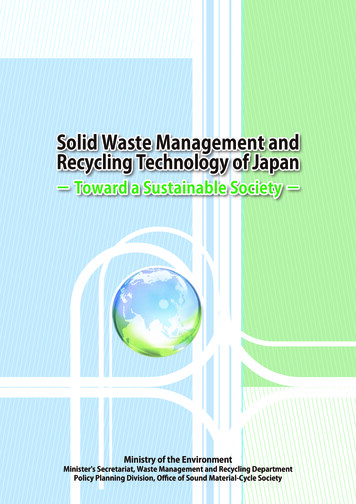
Transcription
Solid Waste Management andRecycling Technology of Japan Toward a Sustainable Society Ministry of the EnvironmentMinister's Secretariat, Waste Management and Recycling DepartmentPolicy Planning Division, Office of Sound Material-Cycle Society
With the aim of preserving the environment in rapidly developingnations, we will introduce Japanese waste management andrecycling technologies, which effectively turn waste into resourcesor appropriately dispose of it.Due to economic development, industrialization and increasingpopulation, problems related to the expanded consumption and depletionof resources, and the increased output of wide-ranging types of waste arebecoming more serious than ever.There is a word in Japan: Mottainai. It encompasses the practice oftreasuring and using all things as long as possible. While economiescontinue to grow, this spirit of Mottainai restrained the generationof waste and motivated the development of technology for reuse,recycling and effective use through heat recovery.As Japan's landmass is limited and finding landfill disposal sites isdifficult, we have developed a system to collect and transport waste,process it through intermediary treatment by incineration and othermethods, and then dispose it in landfills in a sanitary manner, inorder to prevent environmental pollution in the areas surroundingdensely populated cities.This booklet introduces some of leading Japanese waste disposaland recycling technologies.We hope to create a material-recycle society that generates as littlewaste as possible and recycles and reuses wastes as resources, andhope that the most advanced technologies and systems based on ourexperience and achievement may assist to preserve the environmentand recycle resources on a global level.Ministry of the Environment1
CONTENTSMessage11Collection and TransportTechnology for efficient waste transport32Municipal waste incineration technologySafe and sound municipal waste incineration and high-efficiency power generation63Medical waste disposal technology11Sanitary disposal technology with high-environment preservation capability4PET bottle recycling technology14Technology to produce high-grade recycled PET resin and recycle products5Home appliance recycling technology17Technology for high quality recycling that is ecologically safe6Biomass utilization technology20Technology to efficiently recover electricity and fuel from biomass waste7Waste landfill technology24Landfill disposal technology that enables the stabilization of waste in a short timeReference/Legal System for Establishing a "Sound Material-Cycle Society"228
1Collection andTransportTechnology for efficient waste transportIncreased efficiency of wide-area collection and transport through transfer stationsThe expansion of urban areas widens the garbage collection zone. It is possible to improve the efficiency ofcollection and transport operations in cities with widening collection zones by setting up waste transfer stationswhere wastes can be transferred from small- or medium-sized garbage trucks to larger trucks.The cost of collecting and transporting garbage accounts for high percentage of waste disposal operations.Improving the efficiency of collection and transport leads to cost reduction while maintaining or improvingservices to residents.Domestic CaseThe transfer station method commonly adopted in Japan is the compactor container transfer station shown below.Waste craneAdministration BuildingCombustiblebulk wasteCrushingequipmentInputGeneral wasteWeigh-in equipmentDust collection and deodorizing equipmentReceiving hopperWaste feed equipmentCompactorContainer transfer equipmentGarbage collected by small garbage trucks isdropped in a hopper, compressed in containers and reloaded onto larger trucks. In thistransfer station, garbage collected by three2-ton trucks can be compressed in onecontainer.The container is then transported to adisposal site or incineration plant on a largecontainer truck.Source:ShinMaywa Industries, Ltd.Overseas CaseSome Japanese enterprises have established joint ventures in China with high achievements in the productionand sale of transfer stations. Some also sell them to other Asian countries.Transport Station (Xian, China)Transport Station (Kuala Lumpur, Malaysia)3
Setting up transport station to streamline collection and transport operationsTransfer to larger trucks at transport stations improves transport efficiency and reduces fuel consumption bytransport vehicles per garbage volume. This not only leads to cost reduction, but it also reduces CO2 emissions,contributing to the prevention of global warming.Economic effect and CO2 emissions after introduction of transport station Comparison of cost between directtransport and use of transfer station14,000Cost reductionthrough introductionof transfer station912,00010,0008,0006,0004,000Direct transport 50tTransfer station 50tDirect transport 300tTransfer station 300t2,00001020301040Distance (km)CO2 emissions (CO2 in ton/waste in ton per year)Garbage collection and transport cost (1000 yen/waste in ton per year)16,000 Comparison of CO2 emissions betweendirect transport and use of transfer station8Reduction of CO2emissions throughintroduction oftransfer station500km2 Collection area7 Operating days6 CO2 emission factors for250days/year Operating hours5hr./daycollection and transport vehicles0.002619tCO2/L5Collected Collection vehiclevolume4Direct transport 50t/day320Direct transport 50t/dayDirect transport 50tTransfer station 50tDirect transport 300tTransfer station 300t10203040Distance (km)Transfer station 300t/dayTransport vehicle2t packer vehicleTransfer station 300t/day150【Conditions】2t packer vehicle 10t arm roll vehicle※1 Calculated for compactor-container type※2 CO2 calculation is emissions from collection and transport vehicles50Source:ShinMaywa Industries, Ltd.Determination of whether or not to set up transport stations depends on its cost effectiveness. As shown in thefigure below, it is advantageous to introduce a transport station when the total collection and transport fee with thetransport station (TcB) is cheaper than the total collection and transport fee without the transport station (TcA) (TcA TcB).Generally speaking, when the transport distance exceeds 18km, a transport station should be considered.C1Without Transfer Station (Direct Transport)C3C2C4C1DisposalFacilityC3TcA C1 C2 C3 C4TcA:Total cost for collection from collection zones 1 4 anddirect transport to disposal facilityC1,C2,C3,C4:Cost for collection at each collection zone 1 4 andtransport to disposal facilityWith Transfer StationC2C5C4TransportStationDisposalFacilityTcB (C1 C2 C3 C4) Rc C5TcB:Total cost for collection from collection zones 1 4 and transport todisposal facility via transport stationC1,C2,C3,C4:Cost for collection at each collection zone 1 4 and transport totransport stationRc:Cost involving operation at transport station (Construction cost, operationand maintenance management cost)C5:Cost to transport from transport station to disposal facility (Secondary transport)Cost structure for with and without transfer stationDistance where direct transportation is advantageousDistance where using a transfer station is advantageousTcATcBCostWith transfer stationC1 C2 C3 C4 C5:Collection and transportcost to transfer station secondary transport costto disposal facilityWithout transfer station(Direct Transport)C1 C2 C3 C4:Collection andtransport cost todisposal facilityRc:Cost for construction andmaintenance management oftransfer stationDistance to disposal facilitySource:"Waste Collection:Theory and Practice",P145,Maruzen(2011)4
1Collection and TransportTechnology for efficient waste transportFuel-efficient collection and transport vehicles with high load volumeIt would be more efficient in many of the Asian countries to use small collection trucks because of narrowroads. Many of the roads in Japan, too, are narrow, and 1t to 2t compact garbage collection trucks weredeveloped with reduced body weight in order to increase load capacity.There are two types of this garbage collection trucks - mechanical trucks (Mobile Packers) andcompressor-type trucks, but mobile packers are more commonly used. Packers scoop up the garbage with aspinning disk and thrust it into the storage space with a sliding board. Garbage with high moisture contentreduces compression efficiency; however, with continuous modification, trucks have achieved highcompression rate, with 1.5 times more load than flat pile trucks.Compressor-type trucks press down the garbage on to the floor with a compressor board (pressing plate), andafter breaking it up and reducing volume, the garbage is slid into the storage area. The trucks efficiently collectlarge garbage requiring breakdown, bulky PET bottles and plastic waste.Due to the worldwide problem of global warming, low-pollution-type garbage trucks, such as electricmotor-drive and hybrid trucks are being developed and put into practical use.Mobile PackerSafety, loading efficiency and operability are required for garbage collection trucks. Smaller trucks have openingsset less than 800mm above the ground to realize outstanding workability and operability. Low-pollution garbage collection trucks (Example)Generally, garbage loading and unloading ispowered by the engine. This type of truck generates electricity required for loading and unloadingwhile the truck is running. This reduces theconsumption of light oil and CO2 emissions.Source:ShinMaywa Industries, Ltd.ColumnHistory of Garbage Collection Trucks in JapanKitchen waste being collected Truck first used for garbageduring 1950scollection during 1950sTransferring garbage carried by Transferring garbage carried byrickshaw during 1950srickshaw during 1950sSource:100-year History of Cleaning Operations in Tokyo5
2Municipal wasteincinerationtechnologySafe and sound municipal waste incinerationand high-efficiency power generationAdvanced ability to prevent pollution and high-efficiency power generationFrom about 1960, Japan began disposing urban garbage by incineration, and today, Japan possesses theworld's leading garbage incineration facilities. In the fiscal year 2009, there were 1243 incineration facilities inJapan, incinerating garbage using several methods - stoker furnaces, fluidized bed furnaces, and gasificationfusion resource furnaces with the objective of ash recycling. Stoker furnaces account for 70% of all furnaces,and improvement of this type of furnace is progressing rapidly.Today, while high level environmental conservation technologies are being introduced, technologies related tohigh-efficiency power generation and technologies related to safe operation, such as automatic incinerationdevices and automatic cranes, are also being developed. We are now accumulating know-how on handlingdiverse types of garbage of today, ranging from the low-calorie garbage, which was generated whenincineration facilities were first being built, to the high-calorie garbage. Such technology can be utilized for thetype of garbage generated in the Asian region.The newest stoker furnace technology is low air incineration that aims for high-efficiency power generation,which is already under construction in Japan. The figure below shows one example of the latest technology: afacility exhibiting high pollution prevention and high-efficiency power generation capacity.Advanced Waste Incineration FacilityDXNs 0.1ng-TEQ/ NCO 10ppmNOx 60ppmMixed gas is transportedto a large secondaryincineration area thatmaintains a temperatureof 1,000 C to completethe combustion reaction.High efficiencypower generation25% and higherHigh-temperaturehigh-pressure boiler4MPa X 400 CGeneratedpowerSmall and simple exhaust gastreatment systemSlaked limeActivatedcarbonSteamBag filterExhaust gas reduced by 30%Low-temperaturecatalytic desulfurizationdevice Below 170 CEconomizerRecirculation ofexhaust gasSecondary airEnergy recoveryfrom exhaust gasAmmoniaDioxin thermaldecompositionsystemIncineratorUnburned gas is burned at hightemperature when passingthrough the combustion zone,where poisonous substancesare decomposed.Fly ashStackInjection of secondary airand reversal of flamecauses the gas and airto be mixed together.Efficient UsePrimary airInduceddraft fanIgnition loss 1%Efficient use of ashWater-coolingfor fire gratePanel typewater-cooledrefractorySource:Kawasaki Heavy Industries Ltd.6
2Municipal waste incineration technologySafe and sound municipal waste incineration and high-efficiency power generationWaste incineration facilities in residential and commercial areasWith Japan's high-tech incineration facilities, waste incineration has won trust as safe and sound technology,and when planning construction of such facilities, communication with the surrounding residents about risks issmooth, enabling swift progress in plans to construct incineration facilities in urban and residential areas.Some of the incineration plants are shown in the photographs below. Shibuya Incineration Plant / Tokyo (Example)In Tokyo, a metropolis in Japan, thereexists a mixed commercial and residentialarea where a large amount of waste isgenerated. In August 2001, an incinerationplant was constructed near ShibuyaStation in the center of a high-densityurban district. The facility was constructedwith a high technology with a capacity of200t/day, which cleared strict gas emissionregulations for NOx, SOx, smoke, dioxinand other gases. Shibuya IncinerationPlant is small compared to other wastetreatment facilities in Tokyo, and it uses aswirling flow fluidized-bed incinerator.Fluidized-bed furnaces fluidize sand layeron the floor of a tubular furnace with air tomaintain high temperature, which leads toefficient incineration of waste.Operation of the incineration plant ismanaged from the central control roomunder automatic control (ShinagawaIncineration Plant)The waste reservoir is separated fromthe crane operating room by a glassplate and there is no odor. One bucketc
Japan, incinerating garbage using several methods - stoker furnaces, fluidized bed furnaces, and gasification fusion resource furnaces with the objective of ash recycling. Stoker furnaces account for 70% of all furnaces, and improvement of this type of furnace is progressing rapidly. Today, while high level environmental conservation technologies are being introduced, technologies related to .
